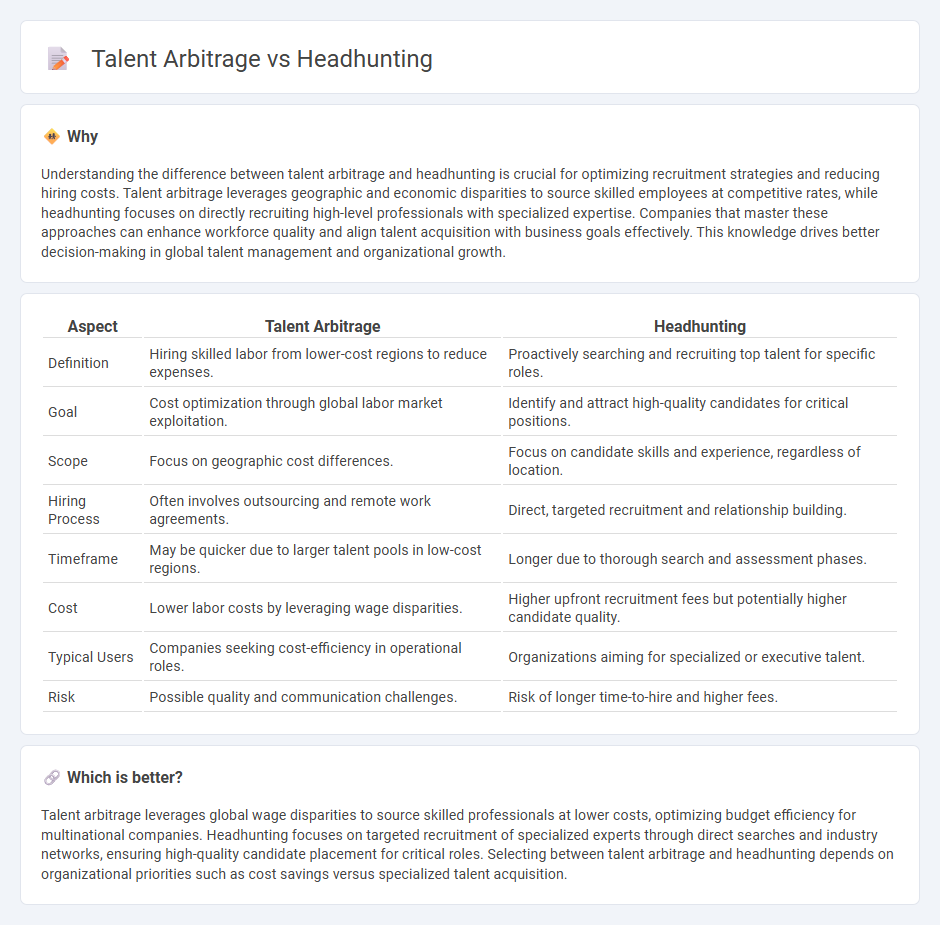
Talent arbitrage leverages global wage disparities to source skilled professionals at competitive costs, optimizing workforce expenses for businesses. Headhunting focuses on actively identifying and recruiting specialized candidates with niche expertise, often for executive or highly technical roles. Explore the strategic benefits and applications of talent arbitrage and headhunting to enhance your recruitment approach.
Why it is important
Understanding the difference between talent arbitrage and headhunting is crucial for optimizing recruitment strategies and reducing hiring costs. Talent arbitrage leverages geographic and economic disparities to source skilled employees at competitive rates, while headhunting focuses on directly recruiting high-level professionals with specialized expertise. Companies that master these approaches can enhance workforce quality and align talent acquisition with business goals effectively. This knowledge drives better decision-making in global talent management and organizational growth.
Comparison Table
| Aspect | Talent Arbitrage | Headhunting |
|---|---|---|
| Definition | Hiring skilled labor from lower-cost regions to reduce expenses. | Proactively searching and recruiting top talent for specific roles. |
| Goal | Cost optimization through global labor market exploitation. | Identify and attract high-quality candidates for critical positions. |
| Scope | Focus on geographic cost differences. | Focus on candidate skills and experience, regardless of location. |
| Hiring Process | Often involves outsourcing and remote work agreements. | Direct, targeted recruitment and relationship building. |
| Timeframe | May be quicker due to larger talent pools in low-cost regions. | Longer due to thorough search and assessment phases. |
| Cost | Lower labor costs by leveraging wage disparities. | Higher upfront recruitment fees but potentially higher candidate quality. |
| Typical Users | Companies seeking cost-efficiency in operational roles. | Organizations aiming for specialized or executive talent. |
| Risk | Possible quality and communication challenges. | Risk of longer time-to-hire and higher fees. |
Which is better?
Talent arbitrage leverages global wage disparities to source skilled professionals at lower costs, optimizing budget efficiency for multinational companies. Headhunting focuses on targeted recruitment of specialized experts through direct searches and industry networks, ensuring high-quality candidate placement for critical roles. Selecting between talent arbitrage and headhunting depends on organizational priorities such as cost savings versus specialized talent acquisition.
Connection
Talent arbitrage leverages global wage disparities by recruiting skilled professionals from lower-cost regions to optimize company expenses and enhance competitive advantage. Headhunting plays a critical role in this process by identifying and attracting top talent with specialized skills that are scarce or expensive locally. Together, talent arbitrage and headhunting enable organizations to access high-quality human capital while managing labor costs effectively.
Key Terms
Executive Search
Headhunting specializes in identifying and recruiting top executive talent through targeted search strategies, focusing on cultural fit and leadership potential to meet specific organizational needs. Talent arbitrage leverages differences in salary expectations and skill availability across regions, optimizing workforce costs while accessing diverse executive expertise. Discover the key distinctions in executive search approaches to enhance your leadership recruitment strategy.
Wage Differentials
Headhunting targets top-tier professionals by identifying and recruiting candidates whose skills and experience match specific organizational needs, often emphasizing salary negotiations based on individual value rather than wage differentials. Talent arbitrage exploits geographic wage differences by relocating roles to lower-cost regions, optimizing labor costs without compromising talent quality. Explore deeper insights into how wage differentials drive strategic decisions in talent acquisition and management.
Cross-Border Recruitment
Headunting specializes in identifying and recruiting top-tier candidates for specific roles, leveraging deep networks and industry expertise to secure talent that precisely matches employer requirements. Talent arbitrage involves sourcing skilled professionals from regions with lower labor costs to optimize budget efficiency while maintaining quality, particularly in cross-border recruitment scenarios. Explore how combining these strategies can enhance global talent acquisition and reduce hiring costs effectively.
Source and External Links
Headhunting vs Recruitment: What's the Difference? - iSmartRecruit - Headhunting is a targeted recruitment process where organizations directly search for and contact potential candidates for senior or specialized roles, often sourcing passive talent not actively seeking new jobs, making it faster and sometimes more cost-effective than traditional recruitment.
What Is Headhunting & How Does It Work? - ecruit - Headhunting involves identifying and reaching out to highly qualified candidates who are usually not actively job hunting, followed by screening, interviews, and helping employers make offers for executive or specialist positions.
What is headhunting and what are its benefits? - Sesame HR - Headhunting is a recruitment technique focused on filling highly skilled or senior roles by proactively contacting select candidates directly rather than using broad job postings, allowing companies to efficiently access top talent.
 dowidth.com
dowidth.com